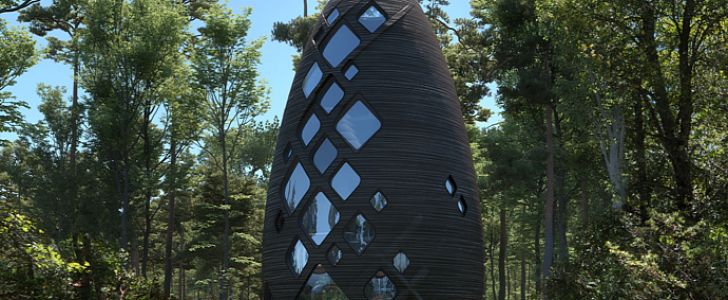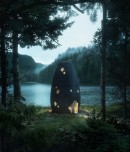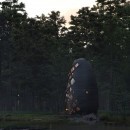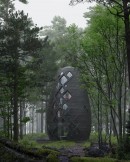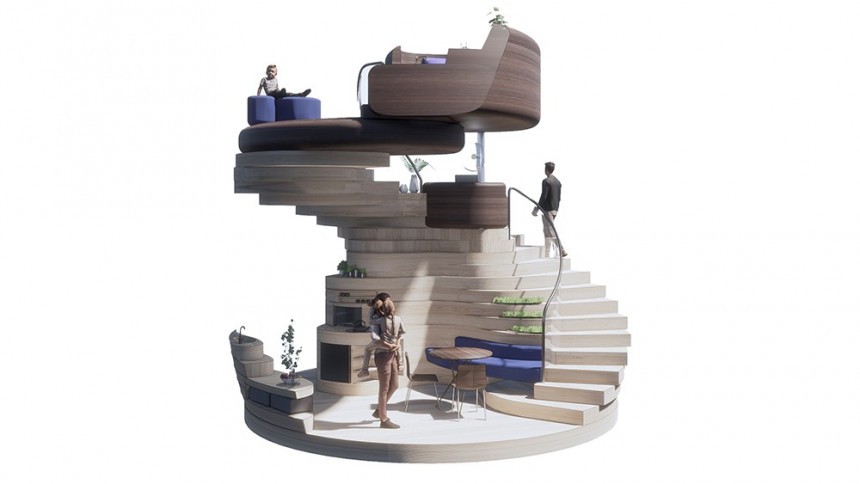As an overused but still applicable saying goes, the future is now. Space technology is being used to build the first-ever, 3D-printed eco-habitat.
The eco-habitat, which is a fancy word to describe a completely self-sustainable home, is called TERA and comes from the team of architects and designers known as AI SpaceFactory. In case you’re wondering what space has to do with building homes on Earth, the answer is simple: this is the same team that delivered a 3D-printed home prototype for Mars, which eventually won a $500,000 NASA award.
That Mars habitat prototype, MARSHA, grew up to become TERA. TERA is “a literal demonstration of how Space technology can reshape how we build and live on planet Earth,” AI SpaceFactory says. In other words, they used everything they learned with MARSHA and applied the technology to conceive a home back on Earth that would come with no footprint, be completely sustainable and make no compromise on comfort.
In June 2019, TERA went live on IndieGoGo to raise funds to build the first unit outside New York, on the banks of the Hudson River. Funding was secured and the unit went into production, with an estimated delivery date for Spring 2020, when it would have become a B&B, with the pledgers as first overnight guests. Given the current international health crisis, all development phases have been pushed back, with the team expecting delays into the delivery by at least another season.
That said, TERA is a beautiful example of the kind of homes we could be living in in the near future. It is 3D-printed from top to bottom and uses materials that reduce waste and pollution, but are twice as strong and durable as concrete. Its outer shell is made from biopolymer basalt composite, which has been validated by NASA to sustain longterm human life on Mars through the MARSHA concept. This composite is developed from crops like sugar cane, and once it reaches the end of life, can be returned back to earth as compost.
That’s the beauty of TERA, the team underlines: it comes from the Earth and returns back to it once it’s served its purpose. But before being turned into compost, the composite can be recycled several times over, and reprinted for other uses. Unlike with concrete and steel buildings, where an estimated 80 percent of materials become waste once the building is demolished, nothing is wasted with TERA.
And it’s just as impressive on the inside as it’s on the outside. The interior is made with birch and poplar, bringing to mind comparisons with a very luxurious (but strikingly minimalist) treehouse. While green, the eco-habitat will be packed with technology meant to make life easier and more friendly on the environment.
The 2-story home has no actual walls and/or rooms to speak of, but main areas placed around a central staircase. The ground floor will consist of the living area, complete with bathroom and shower, food preparation counter and living room with seating area. An indoor aquaponic garden is also in the plans.
The second floor will be adaptable to the future owner’s needs, but on the first unit, it will consist of the sleeping and relaxation area, fitted with a telescope for stargazing. There’s also a wooden terrace that extends the space available on the ground floor, allowing guests to fully take in the breathtaking views.
The open-plan design maximizes air and light circulation, reducing energy consumption. LED lighting and underfloor heating will ensure comfort all the year around, while a graywater recycling system will dispose of the bath and shower water by recycling it to irrigate surrounding land. An off-grid radiating heating and cooling system will be included in future units.
The designers do not say how many people could comfortably live inside TERA, but based on renders made available, the answer is probably at least a family of three. Boasting of being a home “like no other” and the “most sustainable” unit ever conceived, which uses patented space technology, TERA aims to help humans remember simpler and more beautiful times.
“TERA will be a futuristic terrestrial home for this planet – one that emphasizes the beauty of its natural environment,” AI SpaceFactory says. “It offers a simpler, more sustainable solution for building on this planet, while advancing the technologies for living on another.”
That Mars habitat prototype, MARSHA, grew up to become TERA. TERA is “a literal demonstration of how Space technology can reshape how we build and live on planet Earth,” AI SpaceFactory says. In other words, they used everything they learned with MARSHA and applied the technology to conceive a home back on Earth that would come with no footprint, be completely sustainable and make no compromise on comfort.
In June 2019, TERA went live on IndieGoGo to raise funds to build the first unit outside New York, on the banks of the Hudson River. Funding was secured and the unit went into production, with an estimated delivery date for Spring 2020, when it would have become a B&B, with the pledgers as first overnight guests. Given the current international health crisis, all development phases have been pushed back, with the team expecting delays into the delivery by at least another season.
That said, TERA is a beautiful example of the kind of homes we could be living in in the near future. It is 3D-printed from top to bottom and uses materials that reduce waste and pollution, but are twice as strong and durable as concrete. Its outer shell is made from biopolymer basalt composite, which has been validated by NASA to sustain longterm human life on Mars through the MARSHA concept. This composite is developed from crops like sugar cane, and once it reaches the end of life, can be returned back to earth as compost.
And it’s just as impressive on the inside as it’s on the outside. The interior is made with birch and poplar, bringing to mind comparisons with a very luxurious (but strikingly minimalist) treehouse. While green, the eco-habitat will be packed with technology meant to make life easier and more friendly on the environment.
The 2-story home has no actual walls and/or rooms to speak of, but main areas placed around a central staircase. The ground floor will consist of the living area, complete with bathroom and shower, food preparation counter and living room with seating area. An indoor aquaponic garden is also in the plans.
The second floor will be adaptable to the future owner’s needs, but on the first unit, it will consist of the sleeping and relaxation area, fitted with a telescope for stargazing. There’s also a wooden terrace that extends the space available on the ground floor, allowing guests to fully take in the breathtaking views.
The designers do not say how many people could comfortably live inside TERA, but based on renders made available, the answer is probably at least a family of three. Boasting of being a home “like no other” and the “most sustainable” unit ever conceived, which uses patented space technology, TERA aims to help humans remember simpler and more beautiful times.
“TERA will be a futuristic terrestrial home for this planet – one that emphasizes the beauty of its natural environment,” AI SpaceFactory says. “It offers a simpler, more sustainable solution for building on this planet, while advancing the technologies for living on another.”
